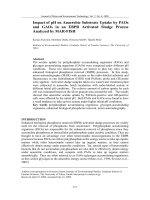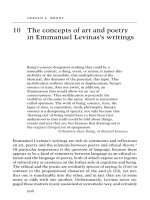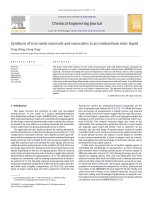Visual art and education in an era of designer capitalism - deconstructing the oral eye
Bạn đang xem bản rút gọn của tài liệu. Xem và tải ngay bản đầy đủ của tài liệu tại đây (5.8 MB, 269 trang )
Visual Art and Education in an Era of
Designer Capitalism
9780230618794_01_prexii.indd i9780230618794_01_prexii.indd i 8/6/2010 4:39:44 PM8/6/2010 4:39:44 PM
Education, Psychoanalysis, and Social Transformation
Series Editors:
jan jagodzinski, University of Alberta
Mark Bracher, Kent State University
The purpose of this series is to develop and disseminate psychoanalytic knowledge that can
help educators in their pursuit of three core functions of education:
1. facilitating student learning;
2. fostering students’ personal development; and
3. promoting prosocial attitudes, habits, and behaviors in students (i.e., attitudes opposed
to violence, substance abuse, racism, sexism, homophobia, etc.).
Psychoanalysis can help educators realize these aims of education by providing them with
important insights into
1. the emotional and cognitive capacities that are necessary for students to be able to
learn, develop, and engage in prosocial behavior;
2. the motivations that drive such learning, development, and behaviors; and
3. the motivations that produce antisocial behaviors as well as resistance to learning and
development.
Such understanding can enable educators to develop pedagogical strategies and techniques
to help students overcome psychological impediments to learning and development, either
by identifying and removing the impediments or by helping students develop the ability to
overcome them. Moreover, by offering an understanding of the motivations that cause some
of our most severe social problems—including crime, violence, substance abuse, prejudice,
and inequality—together with knowledge of how such motivations can be altered, books
in this series will contribute to the reduction and prevention of such problems, a task that
education is increasingly being called upon to assume.
Radical Pedagogy: Identity, Generativity, and Social Transformation
By Mark Bracher
Teaching the Rhetoric of Resistance: The Popular Holocaust and Social Change in a
Post 9/11 World
By Robert Samuels
Television and Youth Culture: Televised Paranoia
By jan jagodzinski
Psychopedagogy: Freud, Lacan, and the Psychoanalytic Theory of Education
By K. Daniel Cho
New Media, Cultural Studies, and Critical Theory after Postmodernism: Automodernity from
Zizek to Lacalu
By Robert Samuels
Visual Art and Education in an Era of Designer Capitalism: Deconstructing the Oral Eye
By jan jagodzinski
9780230618794_01_prexii.indd ii9780230618794_01_prexii.indd ii 8/6/2010 4:39:46 PM8/6/2010 4:39:46 PM
Visual Art and Education in an Era
of Designer Capitalism
Deconstructing the Oral Eye
jan jagodzinski
9780230618794_01_prexii.indd iii9780230618794_01_prexii.indd iii 8/6/2010 4:39:46 PM8/6/2010 4:39:46 PM
VISUAL ART AND EDUCATION IN AN ERA OF DESIGNER CAPITALISM
Copyright © jan jagodzinski, 2010.
All rights reserved.
First published in 2010 by
PALGRAVE MACMILLAN®
in the United States—a division of St. Martin’s Press LLC,
175 Fifth Avenue, New York, NY 10010.
Where this book is distributed in the UK, Europe and the rest of the world,
this is by Palgrave Macmillan, a division of Macmillan Publishers Limited,
registered in England, company number 785998, of Houndmills,
Basingstoke, Hampshire RG21 6XS.
Palgrave Macmillan is the global academic imprint of the above companies
and has companies and representatives throughout the world.
Palgrave® and Macmillan® are registered trademarks in the United States,
the United Kingdom, Europe and other countries.
ISBN: 978–0–230–61879–4
Library of Congress Cataloging-in-Publication Data
Jagodzinski, Jan, 1948–
Visual art and education in an era of designer capitalism :
deconstructing the oral eye / Jan Jagodzinski.
p. cm.—(Education, psychoanalysis, social transformation)
ISBN 978–0–230–61879–4
1. Visual perception—Psychological aspects. 2. Visual perception—
Social aspects. 3. Visual sociology. 4. Art—Philosophy. I. Title.
BF241.J33 2010
701—dc22 2010008777
A catalogue record of the book is available from the British Library.
Design by Newgen Imaging Systems (P) Ltd., Chennai, India.
First edition: October 2010
10 9 8 7 6 5 4 3 2 1
Printed in the United States of America.
9780230618794_01_prexii.indd iv9780230618794_01_prexii.indd iv 8/6/2010 4:39:46 PM8/6/2010 4:39:46 PM
This book is dedicated to
Brigitte . . . always Brigitte
and to Harry Garfinkle, whose genius always remains with me
and to my mom, who at 86 remains an indomitable spirit
9780230618794_01_prexii.indd v9780230618794_01_prexii.indd v 8/6/2010 4:39:46 PM8/6/2010 4:39:46 PM
This page intentionally left blank
Contents
Acknowledgments xi
Introduction: Aestheticization of the Wor(l)d Picture 1
Capturing Affect 2
Commodity of Desire 5
Capitalist Iconoclasm 7
Spectacular Tensions 10
Desire of Commodity 12
Bodily Woes 13
The Synoptic Assemblage 14
Designer Affect 15
Part I Deconstructing the Oral Eye
One Situating the Oral Eye in Designer Capitalism 21
Affective Capture 21
Designing Difference 23
Containing Monsters 26
Make-Up and Over 30
The Digital Dot 33
Steigler’s Technê 37
Two The Fundamental Antagonism of Art & Design 41
Schiller/Kant Problematic 42
Art Becomes Life 45
Life Becomes Art 49
Designer Education/New Media 53
Three Historical Antecedents: The Rise of the Unconscious
in Artistic Practice 59
The Artistic Fragment 59
Repressed Geist 63
Unconscious Genealogy 65
9780230618794_01_prexii.indd vii9780230618794_01_prexii.indd vii 8/6/2010 4:39:47 PM8/6/2010 4:39:47 PM
viii / contents
Part II Ruining Representation
Four On Visual Regimes and Their Shadows 73
On Visual Regimes 73
Readerly Regimes 75
Machinic Vision 79
Virilio’s Disappearances 82
Kairotic Time 84
Actuarial Real Time 87
Virilio’s Shadow 90
Five Visual Cultural Studies and Its Discontents 93
Difference and Sameness 94
Fantasy Formations 100
Cynical Savvy Viewers 104
Six A n Av ant- Garde without Authority: Can
Art (Still) Be Progressive? 109
The Force of Art as Event: Postaesthetics 109
Fabulations 113
Art of Xpression and E(motion) 116
Avant-Garde without Authority 120
Part III Art and Its Education in Designer Capitalism
Seven The Force of Art: Post-Situationism 127
Relational Aesthetics? 127
Post-Situationist In(design) 130
Disruptive Forcework 132
Rhizomatic Forcework 135
Forcework of Productive Reassemblage 137
Forcework of Alternative Information 137
Statement 139
Eight Alain Badiou’s Challenge to Art Education:
The Truth of Art, the Art of Truth 141
Introducing Badiou 141
The Unprecedented Event 144
Truth of Art 146
Configurations as Truth 147
Romantic Misdirection 150
Art Lessons from Badiou 152
9780230618794_01_prexii.indd viii9780230618794_01_prexii.indd viii 8/6/2010 4:39:47 PM8/6/2010 4:39:47 PM
contents / ix
Nine Between Creativity and Innovation? How to Become
a Traitor in Art Education 155
Creativity|Innovation 155
W(h)ither Creativity? 157
Creativity Proper 160
Learning to Learn 163
A Traitor in Art Education 165
Part IV Lessons for Art Educators:
Encounters with the Real
Ten Between Deleuze|Badiou: The Event 171
Topologic s 171
Dice Throw 177
Problematics vs. Axiomatics 179
A Continued Tension 181
Eleven The Art Diagrammatic as In(design):
Affective Encounters 183
Kant Again 184
Lacan|Deleuze on Ethics 185
Two Strategies 188
In(design) Circuits 189
Overloaded Circuits of Bill Viola 190
Overdesigned Circuits: Thomas Hirschhorn 191
Short Circuits: Alfredo Jaar 193
Anamorphic Circuits: Krysztof Wodiczko 196
Bioart-techno Circuits: Eduardo Kac 197
Part V Reorienting Art Education for a
Post-Posthuman Age
Twelve From Eye-World to Brain-Eye: Self-RefleXivity in
Art and Its Education 201
Self-RefleXivity: The Disturbed Spectator 204
Notes 207
References 223
Index 245
9780230618794_01_prexii.indd ix9780230618794_01_prexii.indd ix 8/6/2010 4:39:48 PM8/6/2010 4:39:48 PM
This page intentionally left blank
Acknowledgments
I owe a very special thanks to Lesley Morgan Johnson for her amazing
front cover, as well as to a special class of students who did the “Barbie”
illustrations that appear as section dividers throughout the book, many of
which deconstruct designer capitalism. Many thanks especially to all the
class members. I wish I could have included all the interesting variations,
but that proved not to be possible. To honor all the willing participants
who shared their ideas with me, I wish to thank Lachelle Farris, Emily
Hill, Lesley Johnson, Veronica Juarez, Karly Lagore, Stephanie Lavine,
Melanie Liles, Sarah Lun, Shawn Mackey, Jen Martineau, Christina
Molnar, Glori Palmer, Nadia Poelzer, Natalie Pool, Steph Richmond,
Kyla Satermo, Shelly Seifridt, Kristie Seright, Nekole Thauvette, Lindsay
Twerdoclib, Teresa Wallsten, and Ken Yau—the Advanced Professional
Team (APT) of 2010.
9780230618794_01_prexii.indd xi9780230618794_01_prexii.indd xi 8/6/2010 4:39:48 PM8/6/2010 4:39:48 PM
This page intentionally left blank
Introduction
Aestheticization of the
Wor(l)d Picture
E. J. Dijksterhuis (1961), the great Dutch historian, once characterized mod-
ernization as the “mechanization of the world picture.” Secularization—
brought on by mathematics and the utilitarian pragmatic mind-set of
merchant and laissez-faire capitalism—eventually began to infiltrate all
aspects of life as capitalism continued its aggressive developments. We
can say that postmodernity, which shapes the information society under
designer capitalism, has brought about an ‘aestheticization of the wor(l)d
picture.’ The signifier as word and its signified as image or picture—word
and image together as a post-hieroglyphic sign—are presented “seamlessly”
together as various forms of simulacra—such as xenomoney, which made
its appearance in financial capitalism in 1973. Money refers only to itself
as a sign of exchange. I use the portmanteau term ‘wor(l)d’ to refer to both
‘world’ (globalization) and ‘word’ to indicate the aestheticization of the
image as the manipulation of the sign through de(sign), with the prefix
‘de’ enabling the play of images through perceptual games of privation,
removal, separation, negation, intensity, and reversal—the ‘surrealization’
and serialization of appearances. Hyperreality of image and sound, as hyste-
ricized by Jean Baudrillard, has become business as usual in postindustrial
designer capitalism. Spectators living in globalized world centers are caught
within an information age of consumerism, resulting in a new machinic
assemblage of the synopticon—the panopticon has been inverted.
The metaphor of the oral eye of the subtitle of this book refers not
only to the act of consumption, the isolation of the eyeball as counted
by networks to hold spectators affectively hostage through spectacular
entertainment, but by extension also to the aural ear, which is coexten-
sively tuned to soundscapes that vibrate the body’s molecular being. The
intrarelations of the homonyms oral/aural, as the ‘oralization’ of word,
image, and sound pervade and define our mediated global order. The
other allusion, to the I/eye, should be apparent.
9780230618794_02_int.indd 19780230618794_02_int.indd 1 8/5/2010 11:55:42 AM8/5/2010 11:55:42 AM
2 / visual art and education
This is a rather ambitious book, for it seeks to develop and support artis-
tic and educational practices that remain faithful to the continuation of a
radical attempt to disturb the consumerism of the eye, which de(sign)er
capitalism captures through ‘tele-images,’ as facilitated by tele-technologies
that Derrida (2002, 3) named through two neologisms: “artifactuality”
and “actuvirtuality.” These terms point to the seemingly vanishing gap that
exists between the actual construction of the image and its virtual recep-
tion through the imperative of ‘live’ transmissions. This machinated mode
of screen production is facilitated by the technicity
1
of digitalization, the
Internet (Facebook), and surveillance capture of information to identify a
‘calculable’ body (see Andrejevic 2004).
Capturing Affect
Jonathan Beller (2006) has identified the capture of the oral eye as a “cin-
ematic mode of production,” understood not just in the popular sense of
a cinematic experience, but also in the sense of “the manner in which pro-
duction generally becomes organized in such a way that one of its moments
necessarily passes through the visual, that is, that it creates an image that
(while the tip of the iceberg) is essential to the general management, organi-
zation, and movement of the [capitalist] economy” (10, original emphasis).
Beller brilliantly argues that this expropriation of the visual leads to a gen-
eralized expropriation of attention, what Siegfried Kracauer (1995/1927)
and Walter Benjamin (2008/1936) referred to as “distraction,”
2
thereby
opening up an “attention theory of value.” This extraction of ‘attention’
becomes a productive value for capital in the way it seeks the distributive
‘presence’ of the (interactive) viewer. This “cinematic mode of produc-
tion” has been supplemented and to some degree supplanted in its effective
capture of attention by an interpassive-interactive paradox as presented by
‘new’ media, best exemplified by the paradigm case of the video game and
interactive mobile screen media (iPhone, Wii gaming technology) that are
shaping the posthuman sensorial condition. Perhaps it is better to rename
the process as a capitalist “screen mode of production.” The word ‘screen’
has a rich etymology and genealogy. As Kress (2003) has argued, we have
moved from the page to the screen—the screen referring to protection as
well as projection. Beller asks precisely the question that captures the dif-
ficulty addressed in this book and the challenge that a critical art and its
education would entail:
Could we rethink the hold of the cinema [the production of desire through
the image] on our eyes by producing another way of thinking about it which
at once takes seriously the sublime, the internalized relation of the cinema
9780230618794_02_int.indd 29780230618794_02_int.indd 2 8/5/2010 11:55:42 AM8/5/2010 11:55:42 AM
introduction / 3
with money, the function of the cinema as time machine, and yet which
does not reproduce aesthetics or philosophy or repeat the work of ideology
critique or of psychoanalysis? (Beller 1994, para. 51, emphasis added)
This is a tall order, which I hope to tackle.
Beller, following Walter Benjamin, connects the emergence of the ‘aura’
with the modification of the sensorium brought about by the develop-
ment of the metropolis, where a changed relationship to the visual object
occurs between the perceiver and the perceived. This occurs in relation
to the various forms of looking: from early cinema to the movement of
the flâneur and flâneuse around the arcades, grand magasins, amusement
parks, and cafes of Paris, caught by the lure of the vitrines.
3
Benjamin’s dia-
lectical thesis characterizes the economy of modernization. It is minimally
anthropological where production and reproduction lead to modification as
new conditions emerge from such transformation. To leave the mediation
of technicity out of this account would be to discount the way in which
hominization is itself shaped by technics, which has been the important
preoccupation of Bernard Stiegler
4
(1998, 2009), as will become more and
more evident. The perception of the aura eventually becomes “the subjec-
tive experience of the objective commodification of vision” (Beller 1994,
para. 17). The circulation of the commodity brings about a new value sys-
tem imposed on goods that is attributable to Baudrillard’s (1998) Second
Order of Simulacra, made possible through the electric technologies of
reproduction.
The fetishistic character of objects, attributable to the First Order of
Simulacra, depended on originality, uniqueness, and authenticity. The
frame that surrounds an objet d’art was meant to take it out of circulation
so that the desire to contemplate its transcendence, as that which is beauti-
ful, becomes possible.
5
The aura that surrounds the objet d’art, identifi-
able by the gilded frame, for instance, makes it untouchable, utopian, and
transcendental, and it is usually housed in special institutions—such as
churches, cathedrals, and museums. Such religiosity and creation of awe
can help describe the body’s affective surrender to such objects (and peo-
ple) to the point of weeping and crying, an emotional state in which the
viewer is overwhelmed by the object’s (or person’s) presence.
6
Beauty flips
over into sublimity only when the perceiver is no longer able to maintain
the frame. When the image begins to dominate, a reversal has taken place.
The gap between subject and object is where the negotiation or transfer-
ence of the aura takes place and where questions of desire and surrender
to the image or possession of it arise. The injunction against touching
in churches, cathedrals, and museums ensures that this gap or distance
is maintained. The dissolution of this frame, or rather its repositioning
9780230618794_02_int.indd 39780230618794_02_int.indd 3 8/5/2010 11:55:42 AM8/5/2010 11:55:42 AM
4 / visual art and education
through the tele-technologies into the ‘frameless’ image of digitalization,
marks another approach to art as ‘new media’ and its education in which
touching the screen is often encouraged.
The frame’s function begins to change with the Second Order of
Simulacra, which can be identified with ideology proper, as institution-
ally defined by the state, articulated by Althusser’s (1996, 1997) ‘struc-
turalist’ reading of Marx. Monopoly/cartel capitalism at the turn of the
century reached a position, to use a Hegelian term, ‘for-itself’ (für sich),
from its (often misnamed) earlier laissez-faire ‘in-itself’ (an sich) status
(1880–1918).
7
From the state being a ‘neutral’ player (as conveyed through
Adam Smith’s notion of the ‘invisible hand’), it now becomes, in Alfred
Chandler’s (1977) terms, a ‘visible hand’ aiding and abetting capitalist
expansion. Between World War 1 and World War 2 was when Walter
Benjamin’s thought matured, as the critique of what was the ‘first’ phase
of the ‘society of the spectacle,’ the phase of phantasmagoria,
8
which
the Situationalists, led by Guy Debord, developed. Interpellation, as
Althusser develops it, still holds here, since the belief in an ‘original’ has
not been fully weakened. This happens when capital moves into its latter
phase after World War 2, into what Baudrillard (1993, 50–86) terms the
Third Order of Simulacra: the move from capitalism of production to
that of consumption; from electric to electronic technologies; from the
movement-image to the time-image, in Deleuzian (1986, 1989) terms.
The shift is essentially from closed to open systems of thought, from
‘objectivity’ (positivism) to ‘subjectivity’ (‘emic’ sciences and pluralism
of cultural studies), from internationalism to the globalism of trading
cartels, from ideology to ‘postideology,’ from Marxism to post-Marxism,
from proletariat to ‘multitude,’ from snail mail to Internet, from analog
to digital, and so on.
Above all, perhaps, this is the ontological shift from depth to sur-
face—or, I will argue, from the dominance of space to its supplantation
by time that comes with the cinematic mode of production, which mani-
fests as moments of reorganization of libidinal flows of matter. Zygmunt
Bauman’s (2000, 2003, 2005) ‘liquid oeuvre’ addresses the ‘post’ status of
modernism, where he develops the concepts of ‘liquid life,’ ‘liquid love’ and
‘liquid modernity’ to capture the constant becoming of things. Changes in
social conditions seem to outpace any possibility of members consolidating
habits and routines. Time becomes theorized as a liquid. Speed matters,
not duration; ‘liquid life’ now becomes a consuming life. To put all of this
in another way—globalization is the flattening of the world into a new
cartography. As Henri Bergson had already prophetically theorized at the
turn of the twentieth century, the postmodern sensorium has become a
world of images.
9780230618794_02_int.indd 49780230618794_02_int.indd 4 8/5/2010 11:55:42 AM8/5/2010 11:55:42 AM
introduction / 5
Commodity of Desire
Commodity fetishism, as productively reorganized within monopoly capi-
talism through reproductive technologies, generates lack (manque), in the
Lacanian sense, as the “desire of the Other” (social order). It does this
through magic (an unexplainable event) and suggestion (hypnosis), which
affect the subliminal self; these are the two traits mainstream Freudian and
Lacanian psychoanalysis has largely abandoned.
9
The processes of struc-
turing and interpellating the mass-psyche in this period are performed
through the form of the montage, as Sergei Eisenstein developed it. The
regime of the image, defined as the conflict between two shots that forces
the spectator to think its synthesis, is meant to ‘educate/ discipline,’ within
the proletkult aesthetic.
10
Like the reflexology of Taylorism and Pavlovism,
as the capitalist and communist equivalents, respectively, the ambivalence
between educating and disciplining the body is meant to mobilize action,
to move the body into praxis, but through ‘presentation’ rather than rep-
resentation; to generate belief or what Beller (2006) calls “the productive
value of human attention” (108, original emphasis), thereby achieving
transformation—creating ‘history’ as such by manufacturing the event.
“In our conception a work of art is first and foremost a tractor ploughing
over the audience’s psyche in a particular class context” (Eisenstein Writing,
62; in Beller 2006, 99). Eisenstein’s film The Strike is exemplary in its
dialectical method. Dialectics as mediation “is today actualized as media”
(Beller 2006, 138). In the truest sense, the screened image as impressed in/on
our body’s imaginary is the vanishing mediator. It does its job at the level of
attention, where memory and affect coalesce.
The question that will emerge later in this book is whether the shift to a
nondialectical tradition, as developed by Deleuze|Guattari, might provide
an alternative development to the Marxist-Hegelian philosophical tradi-
tion that has pervaded critical cultural thought: Marx, the social Darwinist
of historical change versus Nietzsche’s Übermensch, signifying a historical
‘Messiah’ yet to appear, where the will to power replaces God to reverse
the master-slave relationship; where Zarathustra, as a prophet of the new
age, challenges a Christianity that fetishizes a utopian heaven rather than a
‘grounding’ in the here and now. This is an ‘aristocratic’ approach, like that
of Deleuze, where the message serves only those who want to hear—it is
not proselytizing in its approach. I will later develop this as an avant-garde
without authority. Yet the dangers of this approach are obvious, for was it
not Benito Mussolini who brought Marx and Nietzsche together, fashion-
ing himself as the ‘superman,’ the Messiah that had come via the National
Socialist Party in Italy that was to meet the crisis of capitalism (Pierson
2001, 23–25)? If Marx is too ‘communist’ in his redemptive Utopianism,
9780230618794_02_int.indd 59780230618794_02_int.indd 5 8/5/2010 11:55:43 AM8/5/2010 11:55:43 AM
6 / visual art and education
then Nietzsche is too ‘individualistic’ in his. Indeed, they were contempo-
raries. There is a fork in the road that persists to this day as to what direc-
tion the critical spirit is to be kept alive that stems from their trajectories.
Commodity fetishism in the Second Order of Simulacra shifts desire
onto the mass-produced object, whereas the copy still derives its lure
from an original that anchors its many possibilities and innovations.
Deleuze|Guattari’s (1987, 167–191) discussion of faciality, especially the
close-up of the affect-image, as developed by the Hollywood ‘star’ sys-
tem of divas, would be an obvious example of Second-Order Simulacra
ideology. The ‘star’ amasses transferential and transcendental ‘light’ not
only from fans, but also from being projected on the ‘big’ screen. Objects
take on a new, sublime dimensionality, and a new force forms an ideal-
ized gaze. There is an accumulation or accretion of memory of the ‘stars’
image simply because of the amount of distributed exposure he or she gets
through the available media outlets. This technology directly targets the
‘suggestive (optical) unconscious,’ which becomes hypnotically entranced
by the early screen faces of Greta Garbo (as Roland Barthes (1972/1957)
once discussed in terms of an absolute state of flesh), Marlene Dietrich,
June Allyson, and Ava Gardner; the moving image in general is made pos-
sible by the mechanical ‘kino eye’ that Dziga Vertov so enthusiastically
promoted as the experiment of a new form of image production freed
from both literature and the theater stage. The link between design and
technology to commodity fetishism again brings in the seeming magic of
unexplainable events, the specter of ghosts, caused not only by accidents
in early photography as afterimages, as well as animated filmic sequences
where objects seem to move by themselves (like the chairs unfolding in
the opening of Vertov’s Man with a Movie Camera), but also by record-
ing instruments that leave the voice disembodied, sounding hauntingly
strange and uncanny.
While the vitrines displayed the mass-produced objects that could not
be touched, which were lit up for presentation, even live mannequins
posed in windows to show off the latest fashions. This remained primar-
ily a generalized feminine space/time. The peep shows in erotic arcades,
however, were reserved for men. Peep shows make the act of looking
conditional on payment, as the image displayed behind the vitrine now
becomes a commodity one has to pay for just to look; “The image of the
commodity becomes the commodity,” as Roberts (1991, 223) puts it.
11
The commodity itself becomes redundant, since the goal of such custom-
ers is masturbation rather than actual contact or coitus. The ephemeral
image generates surplus value that advertising thrives on as the capitalist
art form.
12
Putting money into the slot so that the sexual image is exposed
becomes the very paradigm of libidinal economy. The expenditure of
9780230618794_02_int.indd 69780230618794_02_int.indd 6 8/5/2010 11:55:43 AM8/5/2010 11:55:43 AM
introduction / 7
capital and the expenditure of male desire (ejaculation) are relationally
calculated. It is the dematerialized image that becomes the commodity, with
the movie screen becoming the counterpart structuring technology of the
dematerialized visual commodity image. It is here, of course, where adver-
tising becomes an embedded capitalist practice, establishing itself after
World War 1. “[B]y 1925 advertising was the primary industry, capable
of setting the cultural agenda of radio, film, and later, television as well”
(Wicke 1988, 15). Within monopoly imperialist capitalism, the frame,
like the Model-T, now becomes a standardized screen, a point empha-
sized by Deleuze (1986) when he maintains that “[t]he frame ensures a
deterritorialization of the image” (14–15). It becomes possible to reduce
every image into an exchange value simply through the various develop-
ing technological camera techniques that Vertov, for example, had already
explored: close-up, extreme close-up, morphing techniques, long shots,
dolly shots, and the combination of close-up to cut to establish distance.
The ‘society of the spectacle,’ as Debord theorized it, emerged between
the wars (ca. 1918–1939). It was a time of both capitalist and communist
crisis that included the Stock Market Crash (1929), the Great Depression
(1929–1933), and Stalinism. Besides the advertisement industry, which
established itself by 1925 and where the question of capturing attention
was of central concern, there were a number of other important technolog-
ical developments that addressed Benjamin’s thoughts on the aura: 1927
was the year that television was perfected, the year sound film was devel-
oped, as well as the year when production, distribution, and exhibition
were integrated in the film industry (Crary 1989, 1999). “The introduc-
tion of sync sound transformed the nature of attention that was demanded
of the viewer” (Crary 1989, 102, original emphasis). The hypnotic voice
and the gaze made possible through the recording technologies furthered
the capture of attention. The year 1927 was also when Benjamin began his
Arcades Project, while Henri Bergson—who becomes such a key figure for
Deleuze’s nondialectical approach to perception—received the Nobel Prize
in Literature in 1928, although his philosophy was fading. The importance
of memory for perception that Bergson introduced is of overriding signifi-
cance when it comes to the afterimages that persist in the commerce of
commodities.
Capitalist Iconoclasm
It is useful at this moment to make mention of Ann Kibbey’s (2005)
intervention when discussing “the theory of the image” within capital-
ism. Her key thesis that Calvinist iconoclasm formed the antecedent
event to the commodity fetishism of consumerist capitalism draws a line
9780230618794_02_int.indd 79780230618794_02_int.indd 7 8/5/2010 11:55:43 AM8/5/2010 11:55:43 AM
8 / visual art and education
of disagreement with and a critique of Jean Baudrillard, Roland Barthes,
Jacques Lacan, and Laura Mulvey. Kibbey’s key point is that the per-
formative act of transubstantiation that magically ‘transforms’ ordinary
bread and wine into the body and blood of Christ does so through the
trope of metonymy, which does not require any form of displacement
(like metaphor);therefore, there is no altering of shapes. Such a perfor-
mative act is paradigmatic of the commodity fetish. Upon consumption
of the commodity, one can join the ‘corporate’ body in communion, so to
speak. Metonymic disruption does not generate an image; it is the figura
of the substance that radiates the spiritual presence rather than the qual-
ity of the object. Kibbey maintains that Baudrillard’s “precession of the
simulacra” thesis as a form of apostasy is caught ultimately by his own
nostalgia for the loss of “basic reality,” while Barthes’s thesis in Camera
Lucida reverses what he wrote in Mythologies, wherein second-order signi-
fication is referred to as myth. Instead, the photographic image becomes
reified as “the person’s soul or essence” (31). And, quite rightly following
Goux’s (1991) analysis, Kibbey labels Lacan a hard-core iconoclast, while
Mulvey’s groundbreaking psychoanalytic thesis, for Kibbey, inflects
iconoclasm with sexuality, namely the femme fatale and the fetishized
body of the ‘good’ woman.
What escapes Kibbey’s analysis is the very obvious and elementary
point that Calvin’s iconoclasm by way of metonymy has a long history for
Lacan when he was developing his theory of desire. As a metonymic phe-
nomenon, desire reaches as far back as Plato’s Symposium, where Alcibiades
(a handsome young man) perceives Socrates (who was old and by all stan-
dards ‘ugly’ in looks) as possessing the agalma, the hidden jewel inside
that ugly casing, that Alcibiades lacked—namely, knowledge. As an object
cause of desire, the transference (secular transubstantiation) that Alcibiades
invests in Socrates shows Lacan that the magnetic force of adornment
(which Socrates rejects and denies) is imaginary and fetishistic.
13
The
apostate from the Protestant religion no longer would see bread and wine
as the body and blood of Christ but as just ordinary substances drained
of their magic; that is, drained of desire. Gold turns into shit. This is
precisely the same psychic mechanism that is at work when tribal statues,
some elaborately carved and painted, are then ‘used up’ in some ritual act
of exorcism and shorn of magical power, to be simply discarded (and later
picked up by tourists or archeologists and thereby resignified in museums,
antique stores, and import/export sales). Anyone who has watched Antiques
Roadshow on PBS (Public Broadcasting Service) sees this constantly hap-
pening. What is someone’s trash becomes instant gold, provided there is a
buyer. The object’s worth can only exist within the hype that is bestowed
upon it as a ‘sacred’ secular object, to use an oxymoron.
9780230618794_02_int.indd 89780230618794_02_int.indd 8 8/5/2010 11:55:43 AM8/5/2010 11:55:43 AM
introduction / 9
It has obviously been the genius of Slavoj Žižek (1989) to present the
fetishistic object as a “sublime object of ideology.” Ideology regulates the
relationship between the Symbolic and the Real psychic orders. The fan-
tasy of the Imaginary sustains it through forms of jouissance as well as
affect. These two forms of libidinal energy are not to be equated. The clos-
est Lacanian term for affect is the drive (Trieb), but feminine jouissance,
following Luce Irigaray (1993), may be closer, since this is a difference
formed in multiplicity. Her concept of “the sensible transcendental” para-
doxically fuses mind with body, yet retains women’s difference. It is closer
to Gilles Deleuze’s “transcendental empiricism” as thoughtfully explored
by Tamsin (1999). I will argue later that this is only half the story. What is
often suppressed in Žižek’s oeuvre is not the object cause of desire but the
abject, where the transferential investment is not between the Real and the
Symbolic but between the Real and the Imaginary. There are two forms of
the Real, but the psychic Imaginary remains common to both. I develop this
tension throughout the book as a ‘parallax’ view between the presymbolic
and the postsymbolic Real. What is the more difficult task when it comes
to commodity fetishism is what supports the belief in the exchange value
of goods. What sustains the fantasy, and why should it or should it not be
sustained? Why would anyone pay, for example, several million dollars for
Liberace’s piano (he owned thirty-nine, only one of which was the famous
rhinestone piano that sparkled) that looks like any other piano?
Baudrillard’s final stage of the simulacrum is its ‘pure’ form, which is a
form of consumptive becoming—what, in this book, I refer to as design. The
forms of design in the capitalist sense are characterized by the imposition
of human models through various forms of rationalism and instrumental-
ism and a general coding by means of signs for meaning, along with medi-
ated surveys, so that a prefabricated simulation with a factored end in
sight is achieved. Baudrillard’s idea that there is a perpetual (re) doubling
of the sign so that there is no ‘de(sign)ation,’ no referent, becomes pos-
sible when capitalism presents itself in the für Alle (for all) position. This
is a (post)ideological state of affairs where social class, as Baudrillard out-
rageously claimed, has disappeared, by which he meant, on one level at
least, that it seemed that one’s position relative to the production pro-
cesses in terms of class and status seemed rather trivial compared to the
hype that everyone had access to prestigious consumer goods if they had
the money; the institutionalization of state-wide lottos, available credit,
and more gambling casinos and video lottery terminals assured that such
hype sustained itself. High-ranking call girls and their pimps, and porno
stars and their producers, could drive luxury cars and own mansions as
well. But this is the frailest of arguments, given that designer capitalism
of the simulacrum manages these signs to create new fantasies that keep
9780230618794_02_int.indd 99780230618794_02_int.indd 9 8/5/2010 11:55:44 AM8/5/2010 11:55:44 AM
10 / visual art and education
the socioeconomic arrangements in place (MacCannell and MacCannell
1993). Baudrillard’s theory of seduction, written in 1979 to meet the chal-
lenge of these surface ‘appearances’ and aimed at feminine difference as
championed by Luce Irigaray, did not wash well. Seduction was but a
game, yet another clever way to reinsert masculinity (Plant 1993).
Spectacular Tensions
If the montage shaped attention and affect in this earlier period of
the spectacle as cinematic movement, then it is Cubism in the capital-
ist development and Constructivism in the parallel Russian communist
development that does so in this stage of the spectacle under the signifier
of collage.
14
The collage technique was its ability to capture the unfolding
spectacle of the metropolis by juxtaposing space and time next to and in
front of each other.
15
The assemblage seems to do the same work as collage,
but constructs space in three-dimensional form. It seems more appropriate
for what was developing in Russia concurrently, although the Futurists
used this term as well. The question is to what extent such assemblage is
‘machinic.’ Deleuze (1986, 80–83) makes the claim that Dziga Vertov’s
kino eye offered a ‘montage’ effect that demonstrated a machinic assem-
blage. An inhuman perspective is constructed that is able “to carry percep-
tion into things, to put perception into matter, so that any point whatsoever
in space itself perceives all the points on which it acts, or which act on it”
(81). Vertov’s montage ‘style’ sets up an “empty place” from which can be
observed what constructs the ‘human.’ Such an “empty place” is without
ideology; it anticipates the multiplicity of differences, which will then be
ideologically constituted into statements of truth. But how does one tell
which styles enable such deanthropomorphization to take place, enabling
the unthought and those that recuperate it ideologically? Beller (2006)
makes the case that Eisenstein did the latter, Vertov the former.
Some of this same difficulty emerges with the question of spectacular-
ity. Debord (1977, sec. 63–65) made a distinction in this first phase of the
spectacle between what he termed ‘concentrated’ and ‘diffused’ types. The
concentrated spectacle characterized Nazi Germany, Stalinist Russia, and
Maoist China. Hitler, Stalin, and Mao—figures who were larger than life,
as their monumental portraits were meant to convey—guaranteed national
cohesion and a totalitarian mentality. Debord took the United States as the
model of the diffused spectacle, which was associated with the abundance
of commodities and an undisturbed development of modern capitalism—
the “grandeur of commodity production in general” (sec. 65). But it seems
to me that this distinction can only hold as tendencies during this prewar
time, since Franklin D. Roosevelt and Winston Churchill were equally
9780230618794_02_int.indd 109780230618794_02_int.indd 10 8/5/2010 11:55:44 AM8/5/2010 11:55:44 AM
introduction / 11
strong paternal figures who could just as easily fit the ‘authoritarian per-
sonality’ type, as T. W. Adorno and fellow researchers argued in their 1950
reflective summation of leadership during the war. After World War 2, the
spectacle became “integrated” in Debord’s (1990, VIII, 21–23) view when
he wrote a reflective correction and updating of his original thesis.
It seems to me to be precisely during this interwar period that the fun-
damental antagonism between art & design in modernism that is paradoxi-
cally embedded in the Kantian Critiques, which I explore in chapter two,
comes to a head between the reception of Cubism in Europe and New
York and mid-1920s Constructivism in Russia and its eventual importa-
tion into America via Naum Gabo’s “Realist Manifesto” written in 1920
and co-signed by Antoine Pevsner. It is the antinomy between (capital-
ist) art and (communist) production that appears to repeat an impossible
reconciliation within artistic and utilitarian practice. The Constructivist
critique of Western art was in terms of Marxist commodity fetishism. The
idea was to generate a new proletarian culture with practices integrated
into industrial production and collective reception—proletkult. The new
society was to be developed through Vkhumetas (‘high grade art-technical
workshops’) and Inkhuk (‘Institute of Artistic Culture’) via an avant-garde
of industrial designers, engineers, and architects who were to produce rev-
olutionary functional designs of practical use. Constructivist artists such
as Tatlin, El Lissitzky, and Rodchenko were influenced by the utopian
avant-garde theories of both Saint Simone and Marx attempting to wed art
to life (Rose 1984). Hal Foster (1990) discusses this issue within Russian
Constructivism, which was an overdetermined response to art as condi-
tioned by a bourgeois culture of individual production, reception, ideal
taste, and the patron and open-market system. Could Tatlin, who tried
to find a path between art and production and whose own path took him
in the direction of synthesizing artistic and utilitarian thought through
a “truth to materials,” or Rodchenko, whose own path was a synthesis of
the ideological and the formal, be considered performing the same task
as Vertov’s kino eye? Could any of the Constructivists be conceived as
anything other than ideological statements? It’s difficult to tell, accord-
ing to Foster, but the tension that exists between Vertov and Eisenstein
repeats itself, in the utopian impulses of the kino eye to “create a new,
perfect man” and in the Taylorist impulses that eventually lead to Stalinist
social realism as propagated by Zhdanovism. It seems that the produc-
tivist side of Constructivism was eventually co-opted and recuperated by
the West through Alfred Barr, the director of the Museum of Modern
Art, via the Cubist-constructive tradition, while the Bauhaus seemed to
have been embroiled by the same fundamental tension between useless
art and functionalist design. The more ‘mystical figures’ such as Johannes
9780230618794_02_int.indd 119780230618794_02_int.indd 11 8/5/2010 11:55:44 AM8/5/2010 11:55:44 AM
12 / visual art and education
Itten and Paul Klee, who were opposed to Walter Gropius, Laszlo Moholy-
Nagy, and Ludwig Mies van der Rohe, the supporters of functional corpo-
rate design, were ousted as capitalism moved forward.
Desire of Commodity
Turning to the commodity fetishism of consumerism, which progressively
develops with industrial capitalism after World War 2, Baudrillard’s Third
Order of Simulacra as ‘sign value’ emerges. The aestheticization of the
art-commodity becomes established, along with the dominance of Swiss-
developed Helvetica, which becomes the classical typeface that best repre-
sents the corporate look—clean, tight, secure, and modern, boasting over
forty corporate logos. Baudrillard, who remained close to the Situationists,
gave his controversial talk on Andy Warhol
16
at the Whitney Museum of
American Art in 1987, calling him the prime representative of the renun-
ciation of art, of its disappearance, by turning commodity into an art
form. Only the signature of the artist gives it a differential value within
a system of signs. It was Warhol’s art factory and his machinelike output
that made ‘art’ part of the sign culture, subject to rules, codes of fashion,
and commodification whose value is determined by the market. Warhol
seemed to play an endgame as to where art had ‘arrived’ in the West. It was
the neo-Dada Fluxus group (1962–1978) that attempted an anti-aesthetic
attitude, like Baudrillard himself, to keep the possibility of art open.
17
It is
precisely this Conceptual Art movement in the later 1960s and early 1970s
that tried to evade the market trap—unsuccessfully.
18
However, a strand
of contemporary art that I shall mention in my later chapters eventually
picked up the legacy they left.
Robert Miklitsch (1996, 1998a) attempted to provide an updated ‘gen-
eral economy of commodity fetishism’ as classically developed by Marx by
drawing on Baudrillard’s simulacrum of the sign—calling it “commodity-
body-sign” (79), where use- and exchange- as well as sign-value all come
into play.
19
The commodity (exchange value) and the body (use-value)
are supplanted by the sign in a ‘perverse’ economy. In Baudrillard’s terms,
“The fetishization of the commodity is the fetishization of a product emp-
tied of its concrete substance of labor and subjected to another type of
labor, a labor of signification that is, of coded abstraction (the production
of differences and sign values)” (in Miklitsch 1998a, 78, added emphasis).
Whereas Marxist critics (the Frankfurt School and especially Adorno, who
with his concept of ‘negative dialectics’ pushed and radicalized the dialec-
tic to a point of a ‘utopian impossibility’ in his break with Hegel) stress the
primacy of production of the culture industry within a perverse capitalist
system, along with their resultant pessimism, the tendency of cultural
9780230618794_02_int.indd 129780230618794_02_int.indd 12 8/5/2010 11:55:44 AM8/5/2010 11:55:44 AM









